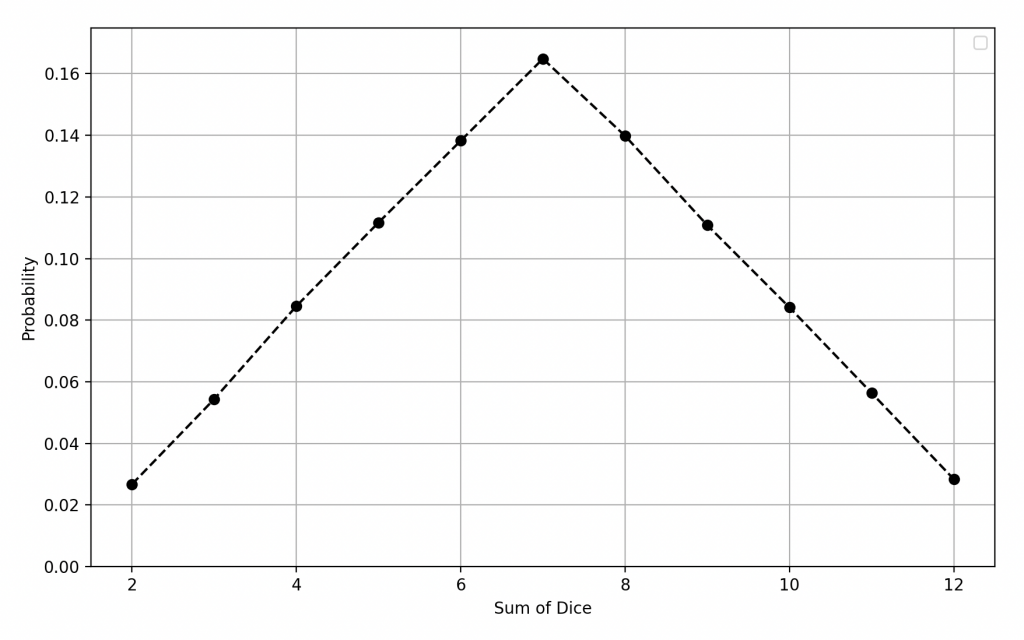The jailer, despite the stench surrounding him, couldn’t help but feel flattered by the elf’s attention. However, he suddenly remembered his duty and shook his head.
Jailer: (resisting the charm) Charming temptation, but you will stay here, filthy and foul. You won’t change my mind.
Unfortunately, the elf had not managed to seduce the jailer, and the situation remained as desperate as before. The adventurers, while holding onto a glimmer of hope, knew that their escape was far from guaranteed. The magician, on the other hand, continued her exposition on the triangular probability distribution, trying to make sense of this chaotic situation.
The Law of Two Dice
Magician: My dear friends, now that you have a solid understanding of the discrete uniform distribution, let me tell you about another intriguing distribution, the triangular distribution. It occurs when we roll two six-sided dice and add the values obtained on their top faces.
Unlike the uniform distribution we discussed earlier, the triangular distribution has a different probability distribution.
For a simple roll of a fair and unbiased six-sided die, the probability of getting any value from 1 to 6 is evenly distributed, which means 1/6 for each result. This constitutes a discrete uniform distribution. However, when we roll two dice and add their values, the outcomes are no longer uniformly distributed but instead follow a triangular distribution.

Sum of the dice is 2: Probability 1/36
Sum of the dice is 3: Probability 2/36
Sum of the dice is 4: Probability 3/36
Sum of the dice is 5: Probability 4/36
Sum of the dice is 6: Probability 5/36
Sum of the dice is 7: Probability 6/36
Sum of the dice is 8: Probability 5/36
Sum of the dice is 9: Probability 4/36
Sum of the dice is 10: Probability 3/36
Sum of the dice is 11: Probability 2/36
Sum of the dice is 12: Probability 1/36

As you can see, the most probable sum is 7, with a probability of 6/36, while the extremes, 2 and 12, have the lowest probability at only 1/36.
There are several possible combinations with two six-sided dice to obtain a specific sum. Let me enumerate them:
To obtain a sum of 2, there is only one possible combination: 1+1.
To obtain a sum of 3, there are two possible combinations: 1+2 and 2+1.
To obtain a sum of 4, there are three possible combinations: 1+3, 2+2, and 3+1.
And so on, until we reach a sum of 12, which has only one possible combination: 6+6.
This triangular distribution is fascinating because it reflects how probabilities are distributed when we combine the results of two dice. Keep in mind that this knowledge could prove useful in your future adventures, as it will allow you to estimate the chances of success when dealing with situations that involve complex dice rolls.
It's not Over !
However, it’s important to remember that everything that has just been told is not the true ending of the story, but rather a variation of what could have happened.
In the world of role-playing games, the possibilities are endless, and the fate of our adventurers often depends on the players’ choices and the Game Master’s decisions. So, let the quest continue because every adventure is unique and unpredictable, and new challenges await our brave heroes in the dark corners.
Find the true ending.
Bibliography
M. Fréchet, M. Halbwachs, Le calcul des probabilités à la portée de tous, Dunod, 1924, 297 p.
C. Barboianu, Probability Guide to Gambling. The Mathematics of Dice, Slots, Roulette, Baccarat, Blackjack, Poker, Lottery and Sport Bets, INFAROM Publishing, 2006, 316 p
P. Nahin, Digital Dice. Computational Solutions to Practical Probability Problems, Princeton University Press, 2008, 263 p.
I. Stewart, Do Dice Play God?: The Mathematics of Uncertainty, 2019
import matplotlib.pyplot as plt
import numpy as np
# Number of simulations
n_simulations = 100000
# Simulations of rolling two dice and calculating sums
results = np.random.randint(1, 7, size=(n_simulations, 2))
sums = np.sum(results, axis=1)
# Calculation of probability density
unique, counts = np.unique(sums, return_counts=True)
probability = counts / n_simulations
# Creating the probability density plot
plt.figure(figsize=(10, 6))
plt.plot(unique, probability, marker='o', linestyle='--', color='black')
# Labeling axes and adding a title
plt.xlabel('Sum of Dice')
plt.ylabel('Probability')
# Limiting the y-axis scale from 0 to the maximum probability
plt.ylim(0, max(probability) + 0.01)
# Displaying the legend
plt.legend()
# Displaying the plot
plt.grid(True)
plt.show()
